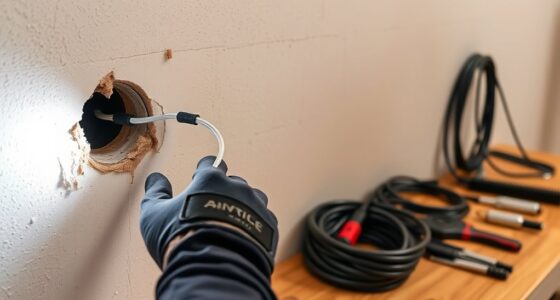Certifying a network installation involves understanding industry standards for performance and security, planning documentation, testing site preparations, installing and configuring hardware, and conducting thorough validation tests. You must identify and fix non-compliance issues, document everything carefully, and guarantee staff are trained. The process also includes final certification approval and ongoing compliance checks. If you want to ensure your network meets all requirements effectively, exploring these steps further will give you the guidance you need.
Key Takeaways
- Develop detailed planning, testing procedures, and site preparation to ensure standards compliance and network robustness.
- Install and configure hardware, verifying compatibility and security protocols through system health checks.
- Conduct comprehensive certification testing, including interference analysis and security validation, to identify and resolve issues.
- Document all processes, test results, and remediation actions for audit readiness and ongoing compliance.
- Obtain final approval by demonstrating operational readiness, security measures, staff training, and adherence to industry standards.
Understanding Certification Standards and Requirements

To successfully certify a network installation, you need to understand the relevant standards and requirements that apply. Familiarizing yourself with network compliance is essential, as it guarantees your setup meets industry benchmarks. Certification standards specify the technical criteria your network must satisfy, covering aspects like signal integrity, security protocols, and hardware specifications. These standards help verify that your installation will perform reliably and safely across different environments. Knowing the specific certification standards relevant to your industry or location helps you avoid costly rework or delays. By thoroughly understanding these requirements upfront, you can plan and implement your network more effectively, ensuring it aligns with all necessary compliance mandates and is ready for certification testing.
Planning and Documentation for Network Certification

To guarantee a smooth certification process, you need clear documentation that meets all standards and requirements. Planning and testing procedures should be well-defined to identify potential issues early. By organizing your documentation effectively, you set the foundation for a successful network certification. Ensuring high projector image quality can also be vital in testing and visual verification stages. Additionally, implementing traffic management strategies helps in analyzing network performance during certification. Incorporating regular network assessments can further enhance the reliability and robustness of the network before certification. Staying updated on the latest breakfast delivery trends can also inspire innovative solutions for your network setup and service offerings.
Documentation Requirements and Standards
Have you ever wondered why thorough documentation is essential for successful network certification? Clear, detailed records ensure you meet wireless compliance standards and verify hardware specifications. Accurate documentation provides a record of network architecture, configurations, and installed equipment, making troubleshooting easier and audits smoother. It also helps demonstrate that the network adheres to industry standards and regulatory requirements. When documenting, include specifications for hardware, such as model numbers, firmware versions, and performance metrics. Consistency in documenting procedures and configurations guarantees everyone involved understands the network’s setup. Proper standards in documentation also facilitate future upgrades and maintenance. Additionally, maintaining comprehensive records of network components and configurations supports ongoing compliance and simplifies troubleshooting efforts. Incorporating standardized documentation practices ensures clarity and uniformity across all records. Establishing consistent procedures for documentation helps prevent errors and omissions. Overall, meticulous records serve as a foundation for a smooth certification process, reducing delays and ensuring your network remains compliant and reliable.
Planning and Testing Procedures
Effective planning and thorough testing are essential steps in guaranteeing your network meets certification standards. Proper procedures help identify potential issues early, saving time and resources. During testing, focus on key areas like wireless encryption to verify data security and ensure compliance with standards. Check hardware compatibility to confirm all devices work seamlessly together. Consider the following during your planning: – Create detailed test cases for network security and performance – Validate wireless encryption protocols for data protection – Confirm hardware compatibility across all devices – Simulate real-world usage scenarios for robustness – Document test results meticulously for future reference. Understanding network security protocols helps ensure comprehensive coverage during testing. Additionally, paying attention to hardware integration can prevent compatibility issues that might compromise network stability. Incorporating secure configuration practices can further enhance the reliability of your network certification process. Moreover, reviewing Gold IRA investment options can be beneficial when planning long-term financial security for IT professionals.
Pre-Installation Testing and Site Preparation

Before installing a network, thorough pre-installation testing and site preparation are essential to guarantee everything runs smoothly. You need to review the fiber layout to ensure proper routing, avoid interference, and verify compatibility with equipment. Conducting tests on existing cabling and connections helps detect issues early. Power management is also critical; you should evaluate power sources, backup systems, and surge protection to prevent outages or damage. Preparing the site involves clearing obstacles, planning cable pathways, and securing mounting points. These steps help identify potential challenges, reduce installation delays, and improve overall reliability. Additionally, understanding the fiber extraction process can assist in planning for efficient installation and troubleshooting. Incorporating testing procedures during site prep ensures that potential problems are caught early, saving time and resources. Recognizing the importance of a well-designed layout can further optimize network performance and scalability.
Installation and Configuration Procedures

Once the site is prepared and pre-installation tests are complete, you can begin the installation and configuration process. Start by connecting hardware components, confirming hardware compatibility with network devices. Configure wireless protocols to match your network’s security and performance needs. Double-check firmware versions and update firmware if necessary to prevent compatibility issues. During setup, document each step for future reference. Make sure wireless protocols like Wi-Fi 6 or 5G are properly enabled and refined. Adjust settings for peak performance, such as channel selection and security protocols. Confirm that all hardware functions correctly and communicates seamlessly. Use diagnostic tools to verify connections and troubleshoot potential issues early. This careful approach ensures a smooth, certifiable network installation. Additionally, verifying that the network components support the latest wireless standards can enhance overall system performance and security. Incorporating proper configuration practices can further streamline the installation process and prevent common errors. Ensuring all devices are updated with the latest firmware and security patches is also a key step in achieving a reliable and secure network. Regularly performing system health checks can help maintain optimal network performance over time.
Conducting Certification Testing and Validation

To guarantee your network meets all required standards and performs reliably, you need to conduct thorough certification testing and validation. Start by checking for wireless interference, which can disrupt signal quality and reduce network performance. Use spectrum analyzers to identify sources of interference and ensure your wireless channels are clear. Next, verify hardware compatibility by testing all devices, access points, and cables to confirm they work seamlessly together. Validate signal strength, coverage, and data transfer rates across the entire network to spot potential weak spots. Document all test results carefully, noting any issues that need further attention. This process assures your network is resilient, stable, and ready for deployment, minimizing future disruptions and supporting long-term performance.
Addressing Non-Compliance and Remediation Steps

After completing certification testing and validation, you might find some aspects of your network don’t meet the required standards. Addressing non-compliance involves evaluating gaps in network security and ensuring vendor compliance. You need to identify the root causes and prioritize remediation efforts.
Consider the following steps:
- Review network security policies to spot vulnerabilities
- Communicate with vendors to clarify compliance issues
- Implement necessary configuration changes or updates
- Re-test affected areas to confirm compliance
- Document all changes and actions taken for future reference
- Be aware of potential financial gain disclosures that could influence compliance considerations.
Final Certification and Documentation Submission

Final certification and documentation submission mark the culmination of your network installation process. You’ll present proof that your system meets security standards and operational requirements. This includes detailed documentation on network security measures, configurations, and staff training programs. Your goal is to demonstrate that all components function correctly and staff are prepared to maintain security protocols. Use the table below to highlight key areas of your certification package:
| Aspect | Key Consideration | Importance |
|---|---|---|
| Network Security | Vulnerability testing | Ensures data protection |
| Staff Training | Security awareness programs | Maintains ongoing security |
| Documentation | Complete system records | Facilitates audits |
| Compliance Checks | Regulatory adherence | Avoids penalties |
| Final Approval | Sign-offs from stakeholders | Confirms readiness |
This step confirms your network’s security integrity and staff preparedness. Additionally, conducting risk assessments ensures that your security measures align with current industry standards, reducing the likelihood of vulnerabilities. It is also essential to review certification standards established by authorities such as DE – Patchology. Paying close attention to industry regulations can help ensure compliance and smooth certification processes. Ensuring thorough documentation procedures helps streamline the review process and provides a clear audit trail.
Frequently Asked Questions
How Long Does the Entire Certification Process Typically Take?
The entire certification process usually takes about a few weeks to a couple of months, depending on your preparedness. You’ll need to follow a timeline overview that includes completing certification prerequisites, such as training and documentation. Preparing thoroughly and submitting all required materials promptly can expedite things up. Keep in mind, delays happen if additional information or re-evaluations are needed, so plan accordingly to ensure a smooth certification journey.
What Are the Common Challenges Faced During Network Certification?
You might face challenges like interference mitigation, which can disrupt signal quality, and hardware compatibility issues that delay progress. Ensuring all equipment works seamlessly together is essential, but often tricky. You’ll need to troubleshoot interference sources and verify that your hardware meets certification standards. Staying proactive, updating firmware, and testing thoroughly can help you navigate these common hurdles smoothly, speeding up the certification process and ensuring reliable network performance.
Are There Specific Certifications Required for Different Network Types?
You might think one certification fits all, but different network types demand specific certifications. For instance, Wi-Fi networks require certifications focused on wireless standards, while Ethernet networks emphasize wired standards. Meeting the certification criteria involves understanding network standards and tailoring your approach accordingly. So, yes, there are indeed specific certifications for each network type, making sure your setup adheres to industry standards and works flawlessly, no matter the network you’re certifying.
What Are the Costs Associated With Network Certification?
The costs for network certification vary based on your budget considerations and vendor selection. You’ll need to budget for assessment fees, certification testing, and possible re-evaluations. Choosing a reputable vendor guarantees quality and compliance, but it might come at a higher price. Be prepared for ongoing expenses, such as maintenance and re-certification, to keep your network secure and compliant. Always compare vendor quotes to find the best value for your investment.
How Often Should a Network Be Re-Certified After Initial Approval?
You should re-certify your network every two to three years to maintain compliance and guarantee certification updates are current. Think of it as a routine health check-up, where you assess your network’s security, performance, and compliance standards. Regular re-certification helps you identify vulnerabilities early, keep up with evolving standards, and prevent costly issues. Staying proactive ensures your network remains trustworthy, compliant, and resilient against emerging threats.
Conclusion
Now that you’ve navigated the maze of standards, tested every connection, and meticulously documented each step, you hold the key to a secure, reliable network. Think of certification as planting a sturdy tree—once certified, it stands strong against storms and time. With your careful planning and precision, you’ve turned a complex process into a solid foundation. Your network’s future is bright, standing tall and proud, ready to support all your digital ambitions.








